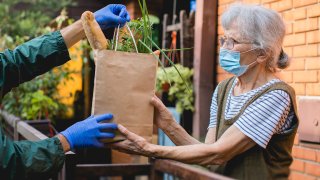

The following content is created in partnership with AARP Foundation. It does not reflect the work or opinions of the NBC Washington editorial staff. Click here to learn more about AARP Foundation and its Meal Pack Challenge 2020.
The year 2020 has been particularly rough on those who’ve already been through some tough times. A prime example: seniors who are in poverty and food-insecure. In 2017, seniors represented 15 percent of the food insecure population in the Washington metro area. This year could easily be worse. Between the dangers of venturing out to get food, spiking prices, and the decline in food donations, the area’s struggling elderly have had big, new challenges to stay fed.
Here’s why some of D.C.’s older adults are struggling even harder to find their next meals—and how a reimagined, remote food drive can help them out.
We're making it easier for you to find stories that matter with our new newsletter — The 4Front. Sign up here and get news that is important for you to your inbox.
Getting food can be dangerous
Seniors have been particularly vulnerable to the devastating effects of the coronavirus. For them, trips to the supermarket can be perilous, given the sharing of indoor space with scores of strangers.
Getting to the food itself can also be challenging. “Seniors may find the health risks of using public transportation to be too high,” says Lisa Marsh Ryerson, President of AARP Foundation. “And help getting to and from the store may not always be available. Difficulty accessing food at the grocery store or congregate meal sites were all factors increasing food insecurity for older adults during this pandemic.”
Buying food online isn’t necessarily an option for these folks either. As Ryerson notes: More than 13 million low-income adults lack home internet access, while some older adults are uncomfortable making online purchases.
In the end, many seniors have had to choose between staying home with limited food access and venturing out, risking their health.
Lack of funds presents even more challenges
One way to cut down on risky grocery store trips is to buy more during each trip. But for struggling seniors, that may not work. “Many older adults, especially those with low to moderate income, can't afford to stock up on groceries,” Ryerson points out.
To make matters worse, the cost of food has risen dramatically since the start of the pandemic. In April alone, the price jumped 2.6 percent, the largest leap in 46 years (the jump is even more drastic for meats, poultry, fish and eggs, at 4.3 percent). “When as little as $5.20 a week in extra food costs can push a person deeper into food insecurity, rising food prices are very troubling,” Ryerson says. “And, as people lost their jobs during the pandemic and sought help, food assistance organizations became overwhelmed.”
As the economy remains bleak, the need for food assistance will only grow. Rising unemployment and poverty rates will result in a 48 to 60 percent increase in food insecurity in the Washington metro region, estimates the Capital Area Food Bank. Meanwhile, the same economic conditions have also taken a bite out of food donations. Many people who normally donate to food banks can no longer afford to do so.
A food drive returns, reimagined for our times
Since 2015, AARP Foundation’s annual Celebration of Service has helped feed millions of vulnerable seniors in poverty with its annual event on Washington D.C.’s National Mall. There, thousands of volunteers have gathered each September 11th to pack millions of meals for food-insecure, older adults.

With this year’s physical distancing requirements, though, such an event is too risky. To make it safe, AARP Foundation reimagined the event as a remote one; a food drive where volunteers could contribute from home. Here’s how it works:
- Volunteers visit Meal Pack Challenge 2020 and request a box (or two or three) and a pre-paid shipping label from AARP Foundation.
- Shopping from a provided grocery list, volunteers will buy groceries safely (either in-person, or online) and fill the box with these food donations—items requested by the Capital Area Food Bank. (Each box costs roughly $20 to pack.)
- From a UPS drop-off site or via a UPS pick-up at their front door, volunteers will send the boxes to the Capital Area Food Bank, which will distribute the food across the D.C. region.
- The drive lasts through the end of September.
While volunteers may miss the camaraderie of the annual Mall event, there’s still an upside: Volunteers can pack boxes from the comfort of their own homes and stay safe while helping out.
Notes Ryerson, “Our goal is to get more food to those in need. However and wherever we can do that, it’s a win for the community.”
Do your part to help feed D.C.’s food-insecure seniors. Click here to volunteer for AARP Foundation’s 2020 Meal Pack Challenge.

